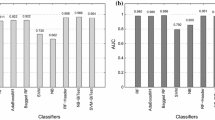Abstract
Unsolicited email campaigns remain as one of the biggest threats affecting millions of users per day. During the last years several techniques to detect unsolicited emails have been developed. Among all proposed automatic classification techniques, machine learning algorithms have achieved more success, obtaining detection rates up to a 96 % [1]. This work provides means to validate the assumption that being spam a commercial communication, the semantics of its contents are usually shaped with a positive meaning. We produce the polarity score of each message using sentiment classifiers, and then we compare spam filtering classifiers with and without the polarity score in terms of accuracy. This work shows that the top 10 results of Bayesian filtering classifiers have been improved, reaching to a 99.21 % of accuracy.
Access this chapter
Tax calculation will be finalised at checkout
Purchases are for personal use only
Similar content being viewed by others
References
Malarvizhi, R.: Content-based spam filtering and detection algorithms-an efficient analysis & comparison 1 (2013)
KasperskyLab: Spam and phishing in 2015 q1 (2015). http://www.kaspersky.com/about/news/virus/2015/Spam-and-Phishing-in-Q1-New-domains-revitalize-old-spam
Saadat, N.: Survey on spam filtering techniques. Commun. Netw. 3(3), 153–160 (2011)
Cormack, G.V.: Email spam filtering: a systematic review. Found. Trends Inf. Retrieval 1(4), 335–455 (2007)
Tretyakov, K.: Machine learning techniques in spam filtering. In: Data Mining Problem-oriented Seminar, MTAT, vol. 3, pp. 60–79 (2004)
Sanz, E.P., Hidalgo, J.M.G., Cortizo, J.C.: Email spam filtering. Adv. Comput. 74, 45–114 (2008)
Teli, S., Biradar, S.: Effective spam detection method for email. In: International Conference on Advances in Engineering & Technology (2014)
Eberhardt, J.J.: Bayesian spam detection. University of Minnesota, Morris Undergraduate Journal, Scholarly Horizons (2015)
Liddy, E.: Natural language processing (2001)
Giyanani, R., Desai, M.: Spam detection using natural language processing. Int. J. Comput. Sci. Res. Technol. 1, 55–58 (2013)
Echeverria Briones, P.F., Altamirano Valarezo, Z.V., Pinto Astudillo, A.B., Sanchez Guerrero, J.D.C.: Text mining aplicado a la clasificación y distribución automática de correo electrónico y detección de correo spam (2009)
Lau, R.Y.K., Liao, S.Y., Kwok, R.C.W., Xu, K., Xia, Y., Li, Y.: Text mining and probabilistic language modeling for online review spam detection. ACM Trans. Manage. Inf. Syst. 2(4), 25:1–25:30 (2012)
Liu, B., Zhang, L.: A survey of opinion mining and sentiment analysis. In: Aggarwal, C.C., Zhai, C. (eds.) Mining Text Data, pp. 415–463. Springer, New York (2012)
Pang, B., Lee, L.: Opinion mining and sentiment analysis. Found. Trends Inf. Retrieval 2(1–2), 1–135 (2008)
Pang, B., Lee, L., Vaithyanathan, S.: Thumbs up?: sentiment classification using machine learning techniques. In: Proceedings of the ACL-02 Conference on Empirical Methods in Natural Language Processing, EMNLP 2002, Stroudsburg, PA, USA, vol. 10, pp. 79–86. Association for Computational Linguistics (2002)
Turney, P.D.: Thumbs up or thumbs down?: semantic orientation applied to unsupervised classification of reviews. In: Proceedings of the 40th Annual Meeting on Association for Computational Linguistics, ACL 2002, pp. 417–424. Association for Computational Linguistics, USA (2002)
Esuli, A., Sebastiani, F.: Sentiwordnet: a publicly available lexical resource for opinion mining. In: Proceedings of LREC, vol. 6, pp. 417–422. Citeseer (2006)
Baccianella, S., Esuli, A., Sebastiani, F.: Sentiwordnet 3.0: an enhanced lexical resource for sentiment analysis and opinion mining. In: LREC, vol. 10, pp. 2200–2204 (2010)
Ohana, B., Tierney, B.: Sentiment classification of reviews using sentiwordnet. In: 9th. IT & T Conference, p. 13 (2009)
Pang, B., Lee, L.: A sentimental education: sentiment analysis using subjectivity summarization based on minimum cuts. In: Proceedings of the ACL (2004)
Acknowledgments
This work has been partially funded by the Basque Department of Education, Language policy and Culture under the project SocialSPAM (PI_2014_1_102).
Author information
Authors and Affiliations
Corresponding author
Editor information
Editors and Affiliations
Rights and permissions
Copyright information
© 2016 Springer International Publishing Switzerland
About this paper
Cite this paper
Ezpeleta, E., Zurutuza, U., Gómez Hidalgo, J.M. (2016). Does Sentiment Analysis Help in Bayesian Spam Filtering?. In: Martínez-Álvarez, F., Troncoso, A., Quintián, H., Corchado, E. (eds) Hybrid Artificial Intelligent Systems. HAIS 2016. Lecture Notes in Computer Science(), vol 9648. Springer, Cham. https://doi.org/10.1007/978-3-319-32034-2_7
Download citation
DOI: https://doi.org/10.1007/978-3-319-32034-2_7
Published:
Publisher Name: Springer, Cham
Print ISBN: 978-3-319-32033-5
Online ISBN: 978-3-319-32034-2
eBook Packages: Computer ScienceComputer Science (R0)




